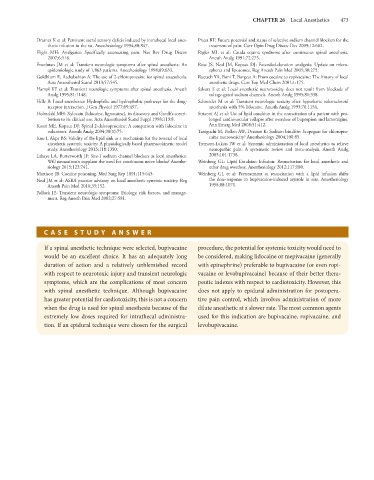Page 487 - Basic _ Clinical Pharmacology ( PDFDrive )
P. 487
CHAPTER 26 Local Anesthetics 473
Drasner K et al: Persistent sacral sensory deficit induced by intrathecal local anes- Priest BT: Future potential and status of selective sodium channel blockers for the
thetic infusion in the rat. Anesthesiology 1994;80:847. treatment of pain. Curr Opin Drug Discov Dev 2009;12:682.
Flight MH: Analgesics: Specifically attenuating pain. Nat Rev Drug Discov Rigler ML et al: Cauda equina syndrome after continuous spinal anesthesia.
2007;6:518. Anesth Analg 1991;72:275.
Freedman JM et al: Transient neurologic symptoms after spinal anesthesia: An Rose JS, Neal JM, Kopacz DJ: Extended-duration analgesia: Update on micro-
epidemiologic study of 1,863 patients. Anesthesiology 1998;89:633. spheres and liposomes. Reg Anesth Pain Med 2005;30:275.
Goldblum E, Atchabahian A: The use of 2-chloroprocaine for spinal anaesthesia. Ruetsch YA, Boni T, Borgeat A: From cocaine to ropivacaine: The history of local
Acta Anaesthesiol Scand 2013;57:545. anesthetic drugs. Curr Top Med Chem 2001;1:175.
Hampl KF et al: Transient neurologic symptoms after spinal anesthesia. Anesth Sakura S et al: Local anesthetic neurotoxicity does not result from blockade of
Analg 1995;81:1148. voltage-gated sodium channels. Anesth Analg 1995;81:338.
Hille B: Local anesthetics: Hydrophilic and hydrophobic pathways for the drug- Schneider M et al: Transient neurologic toxicity after hyperbaric subarachnoid
receptor interaction. J Gen Physiol 1977;69:497. anesthesia with 5% lidocaine. Anesth Analg 1993;76:1154.
Holmdahl MH: Xylocain (lidocaine, lignocaine), its discovery and Gordh’s contri- Sirianni AJ et al: Use of lipid emulsion in the resuscitation of a patient with pro-
bution to its clinical use. Acta Anaesthesiol Scand Suppl 1998;113:8. longed cardiovascular collapse after overdose of bupropion and lamotrigine.
Kouri ME, Kopacz DJ: Spinal 2-chloroprocaine: A comparison with lidocaine in Ann Emerg Med 2008;51:412.
volunteers. Anesth Analg 2004;98(1):75. Taniguchi M, Bollen AW, Drasner K: Sodium bisulfite: Scapegoat for chloropro-
Kuo I, Akpa BS: Validity of the lipid sink as a mechanism for the reversal of local caine neurotoxicity? Anesthesiology 2004;100:85.
anesthetic systemic toxicity: A physiologically based pharmacokinetic model Tremont-Lukats IW et al: Systemic administration of local anesthetics to relieve
study. Anesthesiology 2013;118:1350. neuropathic pain: A systematic review and meta-analysis. Anesth Analg
Lahaye LA, Butterworth JF: Site-1 sodium channel blockers as local anesthetics: 2005;101:1738.
Will neosaxitoxin supplant the need for continuous nerve blocks? Anesthe- Weinberg GL: Lipid Emulsion Infusion: Resuscitation for local anesthetic and
siology 2015;123:741. other drug overdose. Anesthesiology 2012;117:180.
Mattison JB: Cocaine poisoning. Med Surg Rep 1891;115:645. Weinberg GL et al: Pretreatment or resuscitation with a lipid infusion shifts
Neal JM et al: ASRA practice advisory on local anesthetic systemic toxicity. Reg the dose-response to bupivacaine-induced asystole in rats. Anesthesiology
Anesth Pain Med 2010;35:152. 1998;88:1071.
Pollock JE: Transient neurologic symptoms: Etiology, risk factors, and manage-
ment. Reg Anesth Pain Med 2002;27:581.
C ASE STUD Y ANSWER
If a spinal anesthetic technique were selected, bupivacaine procedure, the potential for systemic toxicity would need to
would be an excellent choice. It has an adequately long be considered, making lidocaine or mepivacaine (generally
duration of action and a relatively unblemished record with epinephrine) preferable to bupivacaine (or even ropi-
with respect to neurotoxic injury and transient neurologic vacaine or levobupivacaine) because of their better thera-
symptoms, which are the complications of most concern peutic indexes with respect to cardiotoxicity. However, this
with spinal anesthetic technique. Although bupivacaine does not apply to epidural administration for postopera-
has greater potential for cardiotoxicity, this is not a concern tive pain control, which involves administration of more
when the drug is used for spinal anesthesia because of the dilute anesthetic at a slower rate. The most common agents
extremely low doses required for intrathecal administra- used for this indication are bupivacaine, ropivacaine, and
tion. If an epidural technique were chosen for the surgical levobupivacaine.

